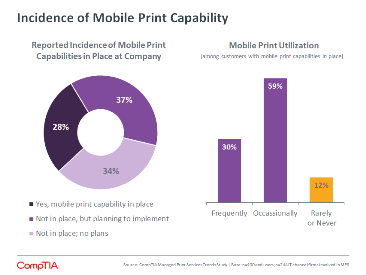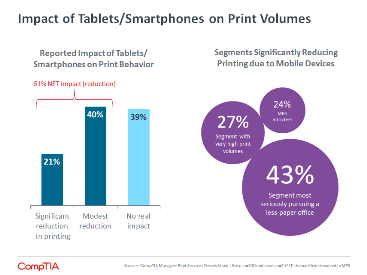More devices. More apps. More anytime, anywhere work and customer engagement. While the mobile trend continues unabated, not all of its elements have matured at the same pace.
Businesses acknowledge playing catch-up in areas such as developing mobile-optimized work flows or effectively manage BYOD security.

Mobile print falls into this category as well. A technology that has been around for some time — Apple iOS AirPrint and the Android PrinterShare app were both available in 2010 — yet has not reached mass market levels of adoption and utilization.
According to recent CompTIA research, 28 percent of businesses report having mobile print capabilities in place. When comparing the responses of IT and business professionals, IT staff report higher levels of mobile print adoption, which indicates some companies may have the capability, but staff are unaware of it. Among the non-adopters, 37 percent plan to add some type of mobile print capability for smartphones and tablets in the near term.
The other key trend associated with the intersection of mobility and print is in the area of print volumes. Consider two simple examples: airport boarding passes and meeting agendas. While printed boarding passes and meeting agendas still dominate, undoubtedly, smartphones and tablets have reduced print volumes in these two cases.
Overall, 21 percent of business professionals report a significant reduction in their personal print volumes due to mobile devices. CompTIA explored this same issue in a 2011 study; at the time 15 percent reported a significant reduction in print due to mobile devices. So even after an explosion of mobile device adoption during the past three years, behaviors apparently have not changed that much. Consequently, it’s tough to say how fast and to what degree mobile devices will reduce print volumes.
CompTIA’s Trends in Managed Print study was published August 2014. The complete report is available to CompTIA Premier Members under the Insight & Tools tab.
Tim Herbert is CompTIA’s vice president of research and market intelligence.


